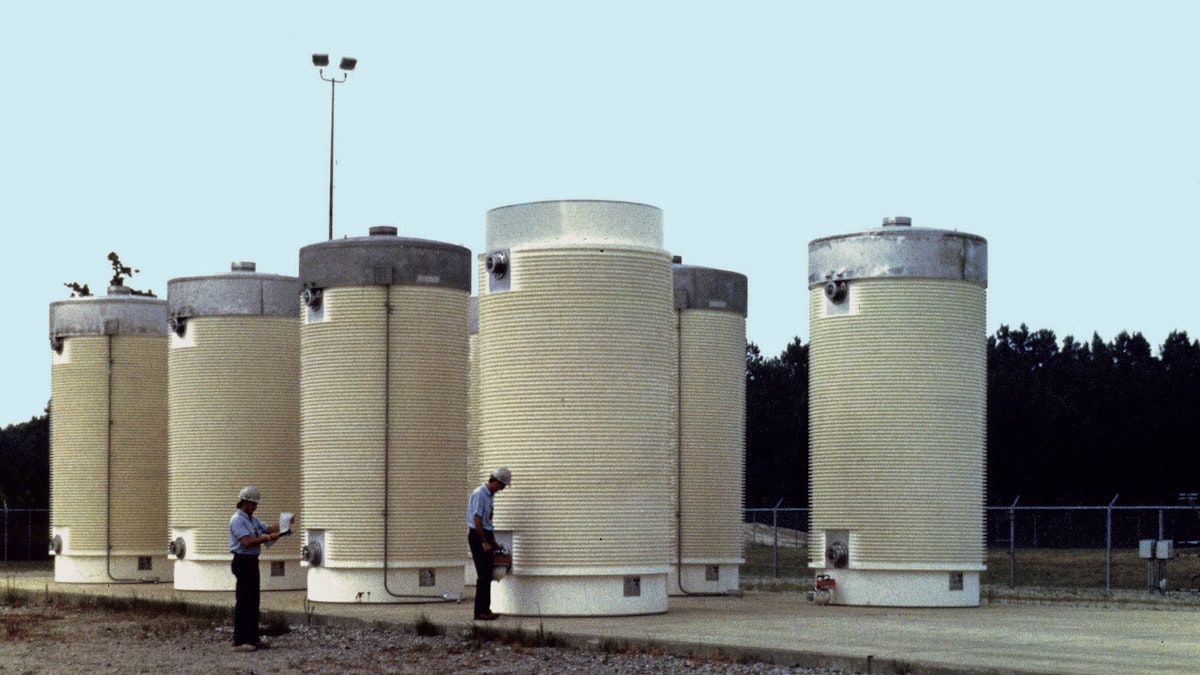The Boring Truth About Nuclear Waste
To meet our decarbonization goal, we’ll need to correct our misperceptions of nuclear waste.

-
-
Share
-
Share via Twitter -
Share via Facebook -
Share via Email
-
When you think about nuclear waste, you might have in mind something like the creeping blobs of green goo on “The Simpsons.” In reality, though, it is a lot cleaner and easier to manage than that. It isn’t the most dangerous waste, or even the longest-lived; a lot of it isn’t even waste. It’s just the most misunderstood of all the types of leftovers that an industrial society produces.
And it is a political football.
To meet our decarbonization goals, which will require ramping up nuclear energy, we’ll need to correct our misperceptions of nuclear waste, understand what the real challenges are, and address the political factors standing in the way of safe, zero-carbon energy.
Some Nuclear Contamination Isn’t a Problem
Radioactive waste from nuclear power reactors takes many forms.
Some of it is lightly contaminated, like tools or protective gloves and coveralls—or even filter material used to purify the cooling water. Those materials can be safely buried in engineered landfills, where they will be isolated until their radioactivity declines to the point that it is no longer a risk to human health. That process can take a few hundred years.
The reactor, too, develops radioactive parts because some of the neutrons, the sub-atomic particles that are set loose when an atom is split (and which are used to split other atoms), end up being captured by atoms of the plant’s concrete, or the reactor’s metal walls. When these atoms absorb the extra neutron, they are “activated,” or made unstable, but they gradually return to stability by giving off radiation and reverting to a harmless non-radioactive form. The most common activation product, Cobalt-60, will be gone after a few decades, which is why owners of reactors that will be decommissioned sometimes propose waiting for years to do the work.
Likewise, some concrete and other building material are also contaminated. But these, too, have been successfully buried in environments where they remain until they are not a health issue. Decommissioning a reactor will produce more than 100,000 tons of material, most of it slightly radioactive. Some of it is not radioactive and will go to an industrial landfill.
The Nuclear Waste Problem
The bulk of the radioactivity from any given nuclear plant, and the material which is the subject of a dispute in this country, is spent fuel. That fuel is the best inventoried, best protected, and best sealed-up used material of any industry, but its final disposition has been the subject of a decades-long standoff.
So what is going on? To explain, we need to first understand what spent nuclear fuel really is.
The current generation of nuclear power reactors in the United States runs on uranium, formed into a ceramic somewhat like the material that makes up a coffee mug. The ceramic comes in the form of pellets about the size of a pencil eraser, and these are stacked in long, thin tubes. The tubes are bundled together into fuel assemblies that are up to 15 feet long and weigh about 1,000 pounds each. When they are new, they are barely radioactive, and technicians can handle them wearing cotton gloves.
That’s to protect the fuel, not the technicians.
The fuel goes into a reactor, where it typically lasts for four and a half to six years. Upon removal, the bundles look the same, rather like a flashlight battery looks the same after its battery is fully run down. Inside the long, thin metal tubes, the ceramic has often broken up, but like a broken coffee mug, it’s still a solid.
But also, like a battery in a flashlight, the chemical makeup of the fuel is altered. As the reactor runs, it splits a small fraction of the uranium atoms, creating fragments that are unstable. They return to stability by giving off a particle or an energy wave, i.e., radiation. Some of the fragments go through several steps, morphing from one unstable form to another until they reach stability.
A reactor also creates new elements by planting one or more stray neutrons in some of the uranium atoms, which results in radioactive “transuranic” elements, of which plutonium is the most common. Some of that plutonium is also split, but a lot remains in the reactor.
Some radioactive atoms return to stability in a few seconds or a few minutes, some in decades, and some in millennia. The transuranics are in the millennia category. The longevity of radioactive materials is measured by the time it takes half the atoms in a sample to degrade to another form is called a “half-life.” (Sometimes, the radioactive atom degrades into a harmless stable form; sometimes, it changes into another radioactive element, which has its own half-life, and will degrade yet again, in a long chain of events.)
“Half-life” is a term in common use, but it is widely misunderstood. Intuitively, it might seem like a long half-life would be a bad thing, but short half-lives are actually the hardest to handle in fuel when it is removed from a reactor. Materials with short half-lives are extremely radioactive but reach stability quickly. Materials with a long half-life, like plutonium, are barely radioactive, but continue emitting radiation for extended periods.
In terms of spent fuel, after a few hundred years (which is a period short enough to make it easy for engineers and geologists to predict the performance of a repository), most of the fragments have lost their radioactivity.
The fragments giving off the most radiation in the first few years—types of cesium and strontium, with half-lives of about 30 years—have been through so many half-lives that they are almost entirely gone. But the transuranics, which were only ever slightly radioactive, are still emitting. Yet from a substance that was initially too radioactive to stand near, now the spent fuel is safe to be around, but probably unwise to eat (and definitely something we want to keep out of drinking water sources).
How to Manage Spent Nuclear Fuel?
Unlike some chemical pollutants like arsenic or mercury, which are eternal, spent nuclear fuel becomes easier to handle over time.
Initially, it is extremely radioactive, and it generates a lot of heat. So, it is plucked out of the reactor by a crane, kept underwater, and moved to a spent fuel pool, where it sits for several years. Spent fuel pools are very deep, and the water shields workers from radiation. Heat exchangers remove heat from the water. If the pool’s cooling systems were lost, because of a loss of electric power, for example, technicians would eventually have to add water to the pool to make up for evaporation or to prevent boiling. The pools are built to withstand earthquakes and other natural hazards.
At reactors, spent fuel pools are quiet places, with a whirr of pumps in the background. The water is very clear but tinted a Ty-D-Bol shade of blue because plant workers have added boron, a chemical that absorbs stray neutrons. (Boron is not toxic; in fact, it is the main ingredient of boric acid eyewash.) Because the water blocks the radiation, technicians walk through the area in street clothes.
After five years or so in the pool, the materials with the shortest half-lives have disappeared, and the spent fuel’s heat production is way down. At that point, it can be lifted by a crane and moved into a steel cask with other fuel assemblies. The cask is drained, and when it is dry, it is filled with an inert gas, so there is no possibility of corrosion.
Once the cask is sealed, it is put inside a small concrete silo. The silo has vent holes at the bottom and top, so air can flow in, around the sealed steel canister, and carry off the heat that is still being generated. These are called “dry casks,” and at power plants around the country, they sit on extra-strong concrete pads, surrounded by barbed wire. The pads look a little like basketball courts at a maximum-security prison.
Most of the casks have no moving parts at all, and some have pressure gauges that monitor the gas inside. Maintenance requirements are quite modest. Over the years, they have been known to shift during earthquakes, or be partially covered with water in floods, but they are designed to withstand being completely submerged or knocked over. After the terrorist attacks of 9/11, some nuclear opponents said they could be breached by armor-piercing shells, but it is not clear if that is true, and in any case, the materials inside are not likely to be a hazard to the public. There are some gases, which would disperse quickly, but nearly all the radioactive material is in ceramic form, not creeping globs of goo, green or otherwise, and would not spread beyond where it sits in the nuclear facility.
Outside the silos, radiation levels are near the background levels anywhere else. But the concrete can be slightly warm to the touch.
Dry casks can be licensed for 40 years, and those licenses can be renewed for 40 years, but as with all nuclear licenses, there are inspection and performance requirements. No casks are yet approaching 80 years of age yet, but it appears likely that they could last much longer. In fact, some casks are at locations where the reactors have long since been demolished and returned to “green field” conditions. So the equipment to empty the casks is no longer readily at hand, and they just sit in place, as inert as a concrete and steel monument. But they are guarded and monitored.
How Much Spent Fuel Is There in the United States?
The national inventory is about 90,000 metric tons, growing by 2,000 tons a year. But this isn’t a big volume because uranium is extremely heavy, about one and a half times denser than lead and two and a half times denser than steel. If the whole volume of spent fuel were stacked on a football field, it would pile up to a depth of fewer than 10 yards, according to the Department of Energy.
In the future, the volume of spent fuel created per unit of electricity produced may go down because the utilities are seeking a uranium blend that is richer in U-235, the type that splits easily, so each assembly would generate heat in a reactor for a longer time. And some of the advanced reactor designs produce waste in other forms, some of which are easier to handle.
The bottom line, though, is that spent nuclear fuel is already securely and safely managed—and it will only get easier to handle over time.
But this is not the way the reactor builders initially expected the fuel to be handled.
Read more in the next part of this series.

